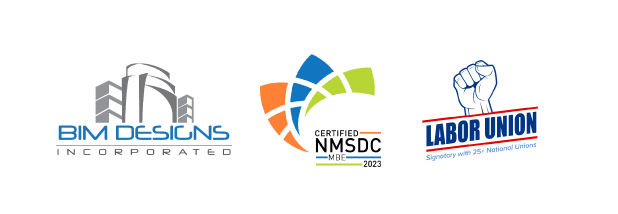
Project coordination is essential for the design, planning, and construction process. Without proper project coordination, a building project could devolve into a mess of confusion, missed deadlines, and wasted resources. However, BIM gives the various professionals on a project a common “language.” Not only that, but BIM also provides a central digital meeting place where people can coordinate through the planning, design, and construction phases.
Plans Evolve in Real-Time for All Team Members
Because BIM design presents changes to the plan as they happen to all who have access to the model, it’s easier for different members of the team to coordinate. This results in several tangible improvements to the design process. For instance, the team can:
1. Maximize Space
For example, the engineer and the interior designer can collaborate on the layout of a dining area. While the interior designer suggests ideas, the engineer can alter structural components to make the spatial ideas both feasible and safe.
2. Schedule with Ease and Efficiency
With BIM project coordination, it’s possible to set up construction schedules. These can then be disseminated to everyone on the pre-construction team so they use them to formulate deadlines. They can also be forwarded to the person in charge of the various construction phases, allowing them to eliminate overlap and other potential delays.
3. Collaborate and Troubleshoot
Because BIM offers a single, shared model, engineers from different disciplines can coordinate their efforts to troubleshoot challenges together. Problems with HVAC system can be fixed while getting input from the structural engineer and electrical engineer because they’re all in the same digital “room.”

Integrated Platform
BIM offers users a unified workspace where several professionals can join forces using a variety of tools specific to their respective disciplines. Each one is integrated into the BIM platform. This has multiple benefits:
Users don’t have to learn “somebody else’s” system. The tools they need for their aspect of design are at their fingertips. They don’t have to switch platforms or try to adapt someone else’s tools to their discipline.
Project coordination is easier because the platform serves as a home base. Because the platform integrates discipline-specific tools, it also “integrates” the professionals working with them.
Common Data Environment (CDE)
BIM’s common data environment (CDE) aids in coordination by providing a unified infrastructure for the storage and dissemination of data. A common data environment acts as a digital storehouse where information is collected, managed, and shared. This includes everything from measurements to complex graphical representations.
When all data is under one roof, sharing takes fewer steps and less time. Any member of the project team only has to go to one place to access everything they need.
A common data environment also results in a single source of truth. Team members never have to doubt as to whether the plan they’re working with is up-to-date because changes are implemented in real-time and made available to everyone who’s given access.
BIM Levels of Project Coordination
There are five levels of BIM, each corresponding to a different level of detail (LOD):
- LOD 100. This is a conceptual level where the model is still very basic. The structure will have been sited and the size, as well as an energy analysis, may be performed. Even at this first level, BIM can help facilitate coordination around preliminary design decisions.
- LOD 200. This is composed of a model featuring approximate geometry. When Level 200 has been completed, the model will have approximate sizes, quantities, and locations for most objects that will be installed in the building. BIM can help engineers from various disciplines coordinate on basic decisions at this level.
- LOD 300. The 300 level contains precise geometry outlining accurate sizes, quantities, and locations of all objects that will be installed. At LOD 300, major clashes are identified, which may require more in-depth coordination.
- LOD 400. LOD 400 also includes precise geometry and requires extensive collaboration because trade scheduling happens at this level. The installation of each element has to be fit into a schedule that takes into account the time and personnel constraints of all the trades involved.
- LOD 500. This is the final, post-construction level, and it contains all building elements, presented in an as-built format. However, some of the finish details may not be included, such as flanges used to connect ductwork. LOD 500 also includes specifications in connection with all machine components, such as HVAC equipment. Like LOD 400, BIM can play an essential role in collaboration at this level, as different professionals contribute details to bring the model up to an as-built standard.

Automatic Clash Detection
Clashes between building components can happen even if one person is working solo on a project. The danger of clashes is greatly increased, however, with several team members working on the same project. BIM provides a flexible anti-clash system that helps identify and eliminate clashes early in the pre-construction phase, allowing professionals to coordinate their efforts to create a more cohesive design. This is accomplished using two tools: clash prevention and clash detection.
- Clash prevention analyzes the design as it develops, identifying clashes as they’re created. For example, if a wall is drawn that goes through the duct system, clash prevention will alert the designer of the conflict. This way, adjustments can be made before the design moves on to the next phase.
- Clash detection helps detect clashes for contractors before they start the building process. When a user runs clash detection over a finished plan, a report is created that outlines all of the clashing components of the project. With clash detection, a contractor can pinpoint problem areas and make adjustments. They also have the option of consulting with the designers and engineers involved to gain further insights.
About BIM Designs, Inc.
BIM Designs, Inc. is an agile BIM design, modeling, consulting, and coordination service provider for architecture, engineering, and construction (AEC) contractors and developers that desire experienced journeymen detailers and engineers for Mechanical, Electrical, Plumbing and Fire Protection (MEPF) modeling, Laser Scanning, and Virtual Design Construction (VDC) projects.
If you need 3D BIM modeling, design, and MEP detailing services, BIM Designs, Inc. (BDI) has the expert tradesmen who know how to precisely design and model your systems. Contact us today for a free estimate or to discuss your project needs.

About the Author
Steve Couch is the Head of Sales and Marketing for BIM Designs, Inc, and is based in Phoenix, AZ. He manages the marketing, sales, and estimating teams to drive revenue and expand client portfolios. An avid international traveler and award-winning public speaker, his experience in public relations, organizational leadership, project management, and communications make him a natural relationship builder, and enables him to build strong community and corporate partnerships.





